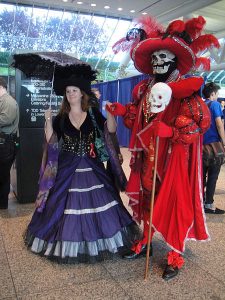This past weekend, I attended the annual Milwaukee Mighty Con, a local comic convention. While there, I watched one of the cosplay competitions where competitors dressed in fantastical recreations of iconic characters such as Star Wars’ Kylo Ren. Yet while observing the competition and enjoying the efforts of the competitors, I pondered the legal implications of these derivative works.
But first, a little back ground information is in order. The term “cosplay” was created by Takahashi Nobuyuki in 1984. Nobuyuki attended a science fiction convention in Los Angeles, and he was so impressed with the fans’ costume competition that he wrote about his experiences upon returning to Japan. Yet, no word in the Japanese language accurately represented the costume competition Nobuyuki saw. To remedy this predicament, Nobuyuki combined the Japanese equivalents of “costume” and “play” to describe what he saw. This created the word “kosupure,” which in English roughly translates into cosplay. Today, this term universally refers to a fan’s wearing of costumes, props, and accessories to represent a character often originating from video games, comics, movies, and TV shows. By extension, the individual who imitates the character is known as a cosplayer. Now, some cosplayers, like the competitors at Milwaukee Mighty Con, can have a monetary benefit from winning cosplay competitions. Such monetary gains naturally bring up concerns regarding the copyrights and trademarks on the imitated characters.
ground information is in order. The term “cosplay” was created by Takahashi Nobuyuki in 1984. Nobuyuki attended a science fiction convention in Los Angeles, and he was so impressed with the fans’ costume competition that he wrote about his experiences upon returning to Japan. Yet, no word in the Japanese language accurately represented the costume competition Nobuyuki saw. To remedy this predicament, Nobuyuki combined the Japanese equivalents of “costume” and “play” to describe what he saw. This created the word “kosupure,” which in English roughly translates into cosplay. Today, this term universally refers to a fan’s wearing of costumes, props, and accessories to represent a character often originating from video games, comics, movies, and TV shows. By extension, the individual who imitates the character is known as a cosplayer. Now, some cosplayers, like the competitors at Milwaukee Mighty Con, can have a monetary benefit from winning cosplay competitions. Such monetary gains naturally bring up concerns regarding the copyrights and trademarks on the imitated characters.
Now, copyright and trademark law protects the imitated characters. These protections allow copyright holders, such as comic book publishers, to protect visual depictions of their characters in derivative works such as replicas, fan films, and costumes.[i] As cosplayers create costumes of typically protected characters, the costume may be a derivative work, if not an outright copy. According to the Berne Convention, a derivative work refers to the “translations, adaptations, arrangements and similar alterations of preexisting works”, which are protected by law.[ii] Typically, merely changing the medium is not enough to make the derivative an original work. The derivative work must have some independent artistic expression sufficient to support a new copyright. This prerequisite is generally referred to in the United States as non-trivial distinguishable variations.[iii] This prerequisite acts as a line in the sand, where potential plaintiffs know when their work is an infringing copy or a protected derivative work.
Now there is no requirement that a cosplayer at a competition must seek to portray their selected character as accurately as possible. In fact, cosplayers are encouraged to personalize their character portrayal by doing such things as combing multiple characters or satirically changing the gender of the character. Thus, if a cosplayer chooses to portray their chosen character as close as possible to the original form, then the cosplayer likely violates the character’s copyright, because the portrayal lacks any creative additions. Meanwhile, the cosplayer who creatively reinterprets their chosen character will likely meet the requisite amount of creativity sufficient to avoid infringement claims.
Yet, a question remains: why is it that cosplayers are not regularly targets of infringement suits? Interestingly, the two biggest copyright holders of the most often cosplayed character are comic book publishers: Marvel and DC. Marvel is home to almost 8,000 characters, including the popular Iron Man and Spider-Man. Likewise, DC houses thousands of popular characters, including Batman and Wonder Woman. Now, traditionally, these copyright holders have delicately balanced not wanting to anger their fans while also trying to profit from their characters. As a result, copyright holders tend to not bring actions of infringement against cosplayers, because it is extremely unwise, from a public relations standpoint. For example, copyright holders tend to enjoy cosplay competitions because it acts as free advertising. There is also a sentimental aspect. Some copyright holders find comradery with cosplayers as some copyright holders started their careers off by participating in comic conventions alongside cosplayers. This is especially true of numerous celebrities, whose first works were published through amateur fan outlets.
In closing, cosplayers’ costuming may infringe upon legally protected characters if they fail to meet the originality standards. However, there is an industry norm where copyright and trademark holders of these characters typically do not act upon these infringement claims. Thus, unless there is a sudden change in industry norms or new laws which force prosecution, it would appear that cosplay and cosplay competitions is here to stay.
[i] See Steve Sunu, Marvel Sends Cease-And-Desist to Anticipated Punisher Fan Film, Comic Book Res. (Oct. 8, 2013, 11:05 AM), http://www.comicbookresources.com/?page=article&id=48344; Darryn Bonthuys, Marvel Drops the Lawsuit Hammer on Iron Man Cosplay Factory, Lazy Gamer (Dec. 19, 2013, 5:00 PM), http://www.lazygamer.net/24/marvel-drops-the-lawsuit-hammer-on-iron-man-cosplay-factory/.
[ii] Berne Convention for the Protection of Literary and Artistic Works, Art. 2(3), Sept. 28, 1979, S. Treaty Doc. No. 99-27 (1986), 1161 U.N.T.S. 3.
[iii] E.g. United States Copyright Office, Copyright in Derivative Works and Compilations, Circular 14 (Oct. 2013), http://www. http://copyright.gov/circs/circ14.pdf.
